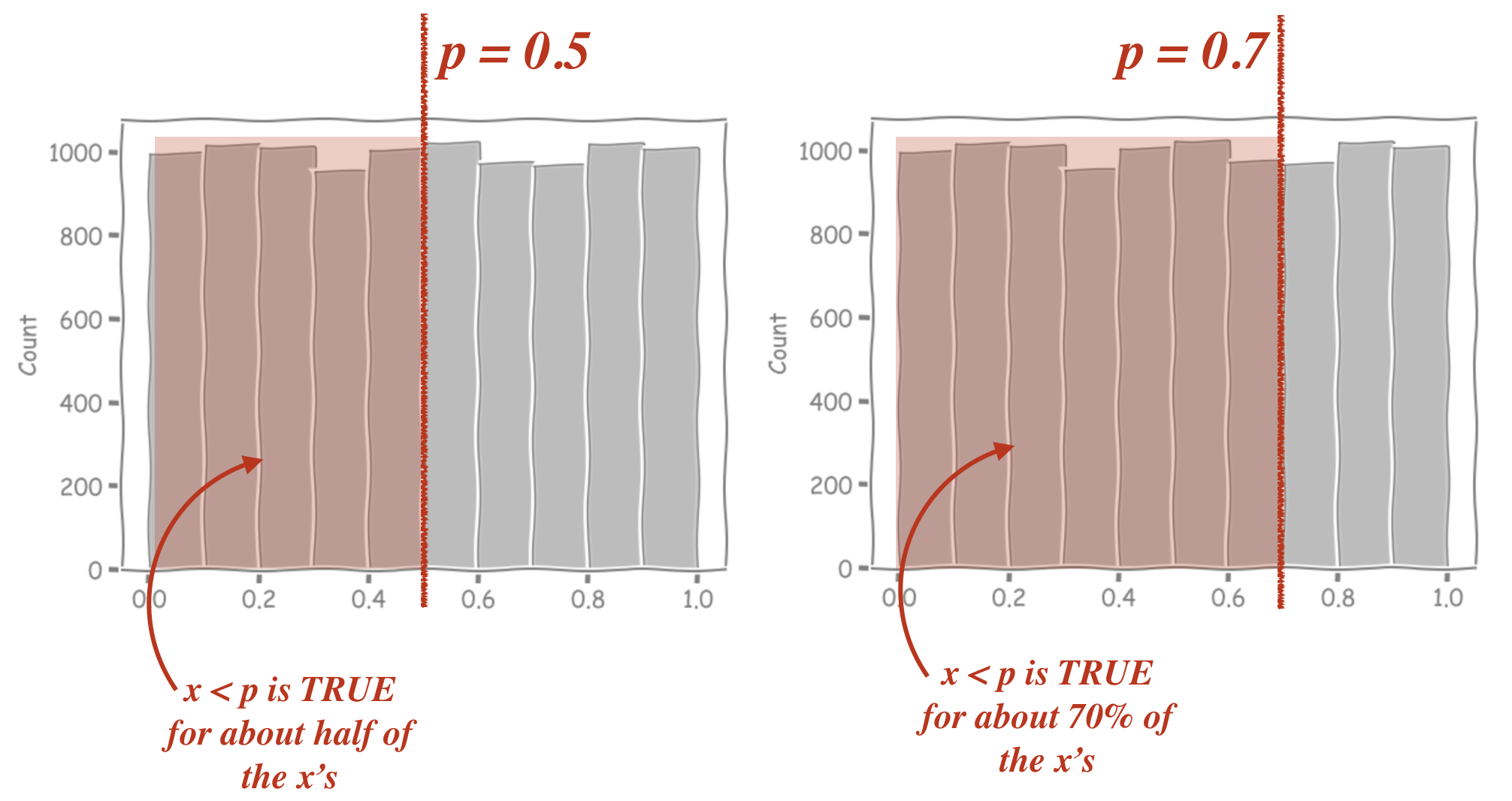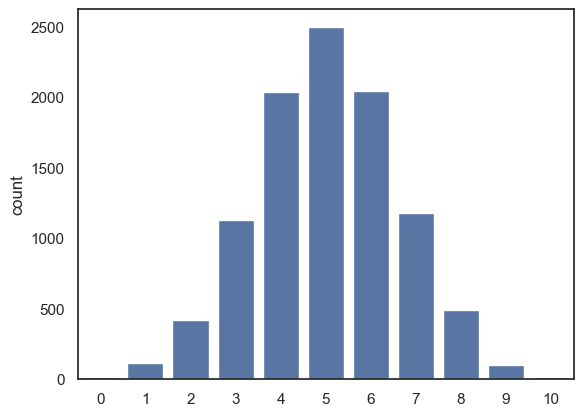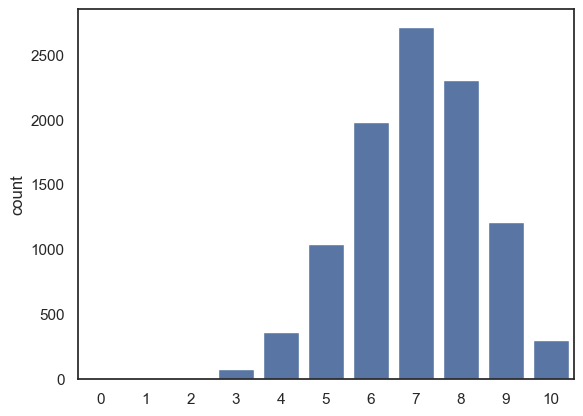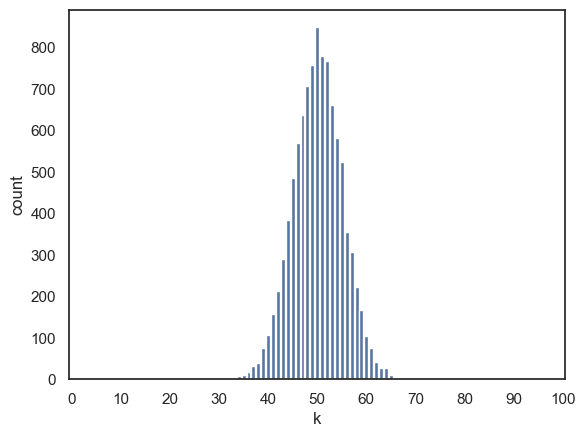2.6. Changing \(n\) and \(p\)#
The binomial has two parameters, \(n\) and \(p\), which together determine the probability of obtaining \(k\) hits:
What happens to the frequency of each value of k, if we change the probability of a hit \(p\), or the number of trials \(n\)?
2.6.1. Set up Python libraries#
As usual, run the code cell below to import the relevant Python libraries
# Set-up Python libraries - you need to run this but you don't need to change it
import numpy as np
import matplotlib.pyplot as plt
import scipy.stats as stats
import pandas as pd
import seaborn as sns
sns.set_theme(style='white')
import statsmodels.api as sm
import statsmodels.formula.api as smf
import warnings
warnings.simplefilter('ignore', category=FutureWarning)
2.6.2. \(p\), probability of a hit#
Think back to our home-baked code to generate a random number with a probability \(p\) of being a hit:
# check if it is less than p - this should happen on a proportion of trials equal to p
x = np.random.uniform(0,1)
p=0.5
if x>p:
hit = 1
else:
hit = 0
print(x)
print('is it a hit?: ' + str(hit))
0.9444967182525487
is it a hit?: 1
If we change the value of \(p\), this changes the proportion of our random \(x\)’s for which \(x<p\) is true. Thhe histograms below show the values of 10,000 outputs from np.random.uniform(), with those that match the criterion x<p highlighted in red

can you see why we used \(x<p\) as a ‘hit’, rather than \(x>p\)?
Distribution of \(k\) depends on \(p\)#
But how does changing \(p\) affect the values of \(k\) we see, when \(k\) is the number of hits out of \(n\) trials (\(n\) coin tosses etc)?
Here is the code for the simulation again, now with \(n\) and \(p\) coded as variables rather than hard coded as 10 and 0.5
n=10
p=0.5
nReps = 10000
k = np.random.binomial(n,p, size=nReps)
sns.countplot(x=k)
plt.show()

What if we change \(p\) to be 0.7 instead?
n=10
p=0.7
nReps = 10000
k = np.random.binomial(n,p, size=nReps)
sns.countplot(x=k, order=range(n+1))
# the argument 'order' is doing a similar job to 'bins' in a histogram
# here I am forcing sns to plot all the possible values of k from 0 to 10,
# even though some of them didn't occur in the simulation
plt.show()

You should notice after modifying the simulation so that \(p=0.7\):
the most common value for k is 7, ie 7/10 hits.
The distribution gets skewed, as we can’t have more than 10/10 hits
Try some other values of \(p\) to get a sense for how changing \(p\) affects the distribution of \(k\).
2.6.3. Mean of \(k\)#
The expected value of \(k\), ie the mean of \(k\) over many repetitions, is given by
In the following code block, we generate 10000 random samples from the binomial distribution \(k \sim \mathcal{B}(n,p)\) and find their mean; we compare it to the value of the mean from the equation, \(np\).
Hopefully it should match!
n=10
p=0.7
nReps = 10000
k = np.random.binomial(n,p, size=nReps)
print('mean(k) = ' + str(k.mean()))
print('np = ' + str(n*p))
mean(k) = 6.9943
np = 7.0
2.6.4. \(n\), number of trials#
If we increase the number of trials to 100, what happens to the frequency distribution of \(k\)?
Here we modify the simulation so that \(n=100\):
n=100
p=0.5
nReps = 10000
k = np.random.binomial(n,p, size=nReps)
sns.countplot(x=k, order=range(n+1))
# the argument 'order' is doing a similar job to 'bins' in a histogram
# here I am forcing sns to plot all the possible values of k from 0 to 100,
# even though some of them didn't occur in the simulation
plt.xlabel('k')
plt.xticks(range(0, n+1, 10));

We can see that the peak of the histogram is where we expect (the most common value of \(k\) is 50, \(np\)) but the spread of the histogram is narrower, compared to the range of possible values for \(k\) (0 to \(n\)) than when \(n\) was lower
2.6.5. Standard deviation of \(k\)#
The standard deviation of \(k\) (or its expected standard deviation over many repetitions of 10 coin tosses) is given by
… where \(q = (1-p)\)
In the following code block, we generate 10000 random samples from the binomial distribution \(k \sim \mathcal{B}(n,p)\) and find their standard deviation; we compare it to the expected value of the standard deviation, \(\sqrt{npq}\).
Hopefully it should match!
n=100
p=0.5
nReps = 10000
k = np.random.binomial(n,p, size=nReps)
print('std(k) = ' + str(k.std()))
print('sqrt(npq) = ' + str((n*p*(1-p))**0.5))
std(k) = 5.042392352842051
sqrt(npq) = 5.0
2.6.6. Standard deviation of \(k/n\)#
We noted above that that spread of the distribution of \(k\), as a proportion of the range of possible values \((0:n)\) decreased as \(n\) increased, in other words that the chance of getting a high or low proportion of hits due to chance decreases when \(n\) is high (this was discussed in the lecture)
The proportion of hits is \(k/n\) and its standard deviation is given by
where \( q = (1-p) \)
This has the interesting consequence that for a given value of p, the standard deviation of the proportion of hits is proprtional to \(\frac{1}{\sqrt(n)}\)
In other words, as \(n\) increases, the proportion of hits I get in a single ‘repetition’ of the experiment (a single set of 10 coin tosses in our example) conforms more closely to the true value of \(p\), the probability of a hit -
in other words, my estimate of \(p\) gets better
but only in proportion to \(\sqrt{n}\)

